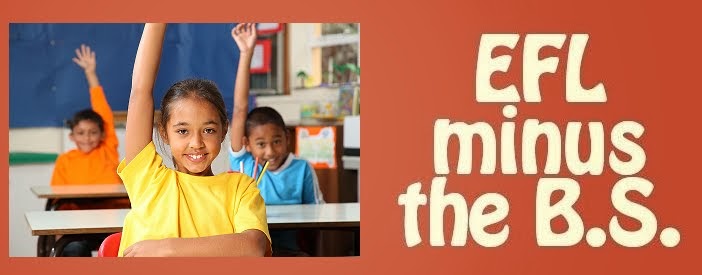KIDS CLASSES --
THINK VITAMISER
You don’t see kids bounding upstairs 3 steps at a time like
you and I do on a good day. Their legs are too little. The same consideration
applies to language learning. You can’t expect 6 to 11 year-olds to absorb big
chunks of new language and retain it much beyond the end of the lesson. The
language needs to be taught little by little, step by step. It’s something that
writers of Children’s EFL text books often overlook, which places the
responsibility on the teacher to break the language input up into small chunks.
Think of yourself as a kitchen vitamiser, reducing the language to ever
smaller, easily-digested bits.
OK, so it’s the ‘At School’ unit. The first page of the unit
has a three-quarter page illustration of a school yard, and under it is a list
of new vocabulary: ‘school yard, playground, soccer field, principal, swings,
slides’, etc.) Now’s the time to switch on the vitamiser. There’s no rush, so
take your time and do it properly. First, make sure the kids have looked at the
picture in detail; not just given it a cursory glance. “Oh, look at this. A
school! I can see lots of children. How many are there? Count them. They’re
having fun, aren’t they! Two girls are going ‘swish’.” (Make a downward sliding
gesture.) “They’re on the - - - - - - .” (Silently mouth the word ‘slide’. Those
who have already checked the word-list, or those who know the word already will
come out with it. “Yes, that’s right: ‘slide’. I’ll write it on the whiteboard.
Uh oh, help me. Does anyone know how to spell ‘slide’? Right. Now everyone
repeat. Again.” Do the same treatment for ‘swings’.
“Now, there are 14 students, but look at these two people
here. They’re not students. What are they? Yes, ‘teacher’ and…. What do we call
this man? The man with no hair?” Continue in this manner, eliciting as many
words as possible, and writing them on the whiteboard, following up with lots
of group repetition. Once you’ve got the new vocab list on the board, (write
the words on the lower half of the board, for a reason that will become
apparent in a moment) there are two more activities to do with it. Number one:
check they’ve retained the meanings. Do this by the pointing exercise. (Do they
already know the word ‘point’? If not, do an introductory exercise. “Point to
your ear, your nose, the door, the teacher….”) Once that’s out of the way, move
onto “Point to the slide, the principal,” etc. Number two: erase a letter from
each of the words and get students to come up and fill in the gaps. When
they’ve got into the swing of it, erase a couple of letters from each word.
Step by step. Little by little.
Some time during the above activities, you’ll probably sense
they’re getting tired or bored. That’s the time for some light relief. Try to
tie this in with the unit. For example, after drilling the words ‘soccer
field’, produce a balloon and let them play balloon soccer for five minutes.
Then, back to the book.
Applying the vitamiser method slows up the lesson, but does
achieve a superior rate of retention. And, anyway, what’s the big hurry? It’s
far better to lodge the language in the children’s heads, rather than give it
an airing and find that it’s forgotten by tomorrow.
xxxxxxxxxxxxxxxxxxxxx
If you
only read one book this year, read 50
Shades of Grey by E.L. James. But if you’re casting around for a second
book, EFL minus the B.S. ain’t half bad.

No comments:
Post a Comment